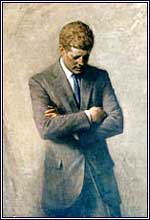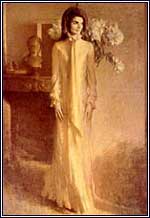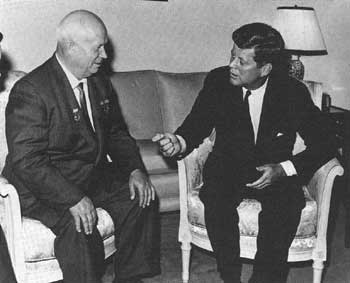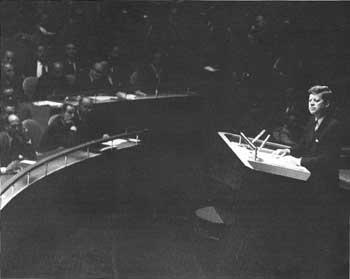






Biographical Sketches
|
JOHN F. KENNEDY Thirty-Fifth President • 1961-63 |
 John F. Kennedy | |
| ||
John Fitzgerald Kennedy was born in 1917 at Brookline, Mass., a Boston suburb. He was the second child and second son of nine children. Both parents were well-educated members of prominent, prosperous, and politically active Irish-American families. The father, Joseph P., was to build a multimillion dollar fortune in business and finance as well as serve as Franklin D. Roosevelt's chairman of the Securities and Exchange Commission (1934-35) and Ambassador to Great Britain (1937-40).
In 1927, by which time Joseph had achieved considerable wealth, the family moved to the New York City area. He soon acquired a winter home at Palm Beach, Fla., and a summer retreat at Hyannis Port, Mass. Young Kennedy received most of his early education at private schools. After graduation from Choate (1931-35), a prestigious college preparatory institution in Wallingford, Conn., he decided to enroll at Princeton University. But, while studying for the summer at the London School of Economics in England, he was stricken with jaundice. This delayed for a few weeks his entry at Princeton. During the winter, his illness recurred, and he was forced to leave school.
Kennedy entered Harvard University in 1936. During the second half of his junior year, he joined his Ambassador-father in England and traveled around Europe. In 1940 he took his B.S. degree from Harvard with honors in political science. His senior thesis, on the appeasement of Hitler, published under the title of Why England Slept, became a bestseller. Later that same year, he enrolled in Stanford (Calif.) University Business School, but only attended for 6 months, after which he toured South America.
During the fall of 1941, Kennedy was appointed as an ensign in the Navy and assigned to Washington, D.C., and then to Charleston, S.C. Just after Japan attacked Pearl Harbor in December, his request for sea duty was granted. After appropriate training in Rhode Island, in 1943, as a lieutenant (jg), he commanded a motor-torpedo patrol boat (PT-109) in the Solomon Islands region of the South Pacific. A Japanese destroyer rammed and sank his craft. Despite a chronic back condition, he helped his crew reach safety. He was awarded the Purple Heart and the Navy and Marine Corps Medal. Finishing his military career in hospitals and as a training instructor, he was discharged early in 1945 with the rank of lieutenant.
Later that same year, employed by the Hearst newspapers, Kennedy reported on the formation of the United Nations at San Francisco, the Potsdam Conference, and the British elections. This activity whetted his interest in politics.
 Jacqueline "Jackie" Kennedy |
In 1946, after receiving a substantial plurality in the Democratic primary, he was elected to the U.S. House of Representatives from a Massachusetts district that included parts of Boston. In 1948 and 1950 he easily won reelection. Two years later, following a highly organized and energetic campaign, he defeated incumbent U.S. Senator Henry Cabot Lodge, Jr., though the Republican Presidential ticket carried the State.
The next year, Kennedy married Jacqueline Lee Bouvier. She was to bear one daughter, Caroline B., and two sons, John F., Jr., and Patrick B., the latter of whom died shortly after birth.
While convalescing from two critical spinal operations in 1954-55, Kennedy wrote Profiles in Courage (1956), a study of eight U.S. Senators who adhered to principle above political popularity. The book won the Pulitzer Prize for biography.
In 1956 Kennedy narrowly lost a bid for the Democratic Vice-Presidential nomination. Two years later, he was overwhelmingly reelected to the Senate. Before long, he began to campaign for the Presidency. After carrying several early State primaries, he won decisively in West Virginia. The national convention selected him on the first ballot. His major rival, Senate Majority Leader Lyndon B. Johnson, accepted the Vice-Presidential nomination.
After a campaign that featured four nationally televised debates between Kennedy and the Republican nominee, Vice President Richard Nixon—a historical first—Kennedy achieved an extremely narrow victory in the general election. Republican claims of fraudulent returns in Texas and Illinois were not pressed.
Kennedy exerted boldness in foreign affairs, which were marked during his administration by sharp intensification of the Cold War. Soon after his inauguration, in 1961, he allowed a force of anti-Communist Cuban exiles, who had been equipped and trained with U.S. assistance, to invade their homeland at the Bay of Pigs. This attempt to overthrow Premier Fidel Castro failed dismally, and Kennedy publicly accepted responsibility.
 |
| President Kennedy confers with Soviet Premier Nikita S. Khrushchev at Vienna in 1961. (National Park Service, Special Collection.) |
That same year, the President launched the Peace Corps and his hemispheric Alliance for Progress to aid developing nations. He also held talks on a variety of topics with Soviet Premier Khrushchev in Vienna, but, especially in the wake of the Cuban affair, these were ineffective. International rapport further declined when East Germany constructed a wall to isolate West Berlin from the Communist or eastern sector. In retaliation, Kennedy augmented U.S. forces in Europe, and 2 years later delivered his "Ich bin ein Berliner" ("I am a Berliner") speech at the wall. Meanwhile, both Russia and the United States had enlarged their military budgets and resumed nuclear testing.
Responding to pro-Communist revolutionary activity in Southeast Asia, in 1962 Kennedy helped arrange a negotiated settlement of the longstanding political turmoil in Laos. That same year, he began augmenting the military advisers President Eisenhower had sent to South Viet-Nam with special forces.
In October 1962 a major crisis arose over Cuba. Kennedy obtained aerial reconnaissance photographs proving that the Soviet Union had placed there intermediate-range missiles capable of striking the U.S. mainland. In an emergency telecast to the Nation, Kennedy stated that the U.S. Navy would quarantine arms shipments to the island until the offensive weapons were with drawn. Nuclear war seemed imminent, but the confrontation ended when Khrushchev agreed to remove the missiles.
 |
| Kennedy addressing the United Nations General Assembly in New York City, September 25, 1961. (National Park Service, Special Collection.) |
Kennedy soon sought new understanding in Russian-American relations. In 1963 he signed the first arms-control treaty of the Cold War with the Soviet Union and Great Britain; it banned aboveground nuclear testing. He also agreed to the installation of a "hot line" for instant communication between the White House and the Kremlin, and approved the sale of surplus wheat to Russia.
Kennedy's "New Frontier" domestic program was only partially successful in Congress, which passed legislation in the fields of reciprocal international trade, aid to higher education, urban renewal, a higher minimum wage, relief of economically distressed areas, liberalization of Social Security procedures and benefits, grants to States for community mental health centers, and improvement of water quality. Civil-rights and tax-reduction measures he recommended were enacted after his death. Congress rejected his proposals for a Cabinet-level Department of Urban Affairs, medical care for the aged, general Federal assistance for public schools, and stronger regulation of farm production.
| HISTORIC SITES & BUILDINGS |
 Kennedy National Historic Site Kennedy Compound. |
But Kennedy made notable gains in civil rights. He appointed many blacks to Federal posts, legally ended religious and racial discrimination in housing built or purchased with Federal funds; strengthened equal job opportunity in Government contract work; and backed the extensive program of his brother, Attorney General Robert F. Kennedy, for the registration of black voters.
To foster school integration, Kennedy sent U.S. marshals and troops to Oxford, Miss., to insure enrollment of the University of Mississippi's first black student, James H. Meredith. He also dispatched Federal forces to the University of Alabama for similar purposes. And he endorsed Martin Luther King, Jr.'s massive civil-rights march on Washington, D.C. (1963).
Kennedy proved to be forceful in other areas, too. After the first U.S. suborbital space flight in 1961, he imaginatively established as a national goal the landing of a man on the moon by the end of the decade. In 1962 he personally intervened to stop proposed steel price increases, which he feared would be inflationary.
During the fall of 1963, Kennedy visited various areas of the Nation to build support for administration programs and his reelection. While touring Texas, on November 22, 1963, to the shock of the world, he was shot from ambush as his motorcade passed through downtown Dallas. He never regained consciousness. His widow (now deceased), daughter Caroline, and son John, Jr. (now deceased), survived him.
 |
 |
http://www.cr.nps.gov/history/online_books/presidents/bio35.htm
Last Updated: 04-Feb-2004